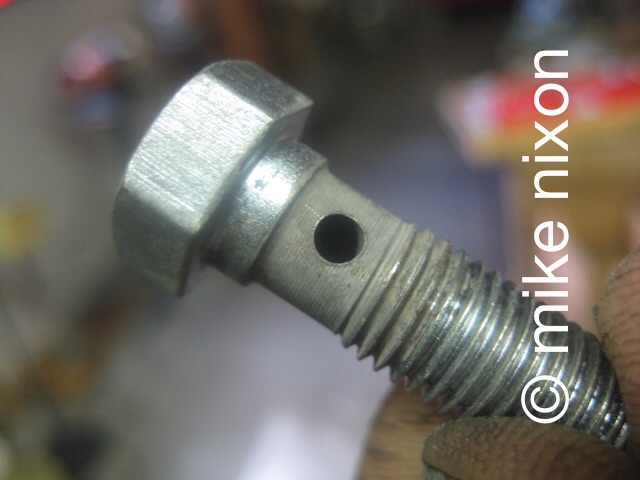  ® ®
|
Silicone brake fluid Revision 4, December 2023 |
|
Why silicone brake fluid is as controversial as it is in the powersports world is a mystery. It isn't in the vintage car world. Owners of classic American cars are all over this. In fact, there is hardly a more significant and more beneficial thing you can do to your vintage Honda motorcycle than to switch its hydraulic brakes to silicone. In contrast to what the other (glycol) fluid will do to a bike that is ridden less than a couple thousand miles in a year, silicone brake fluid will make your brakes fix-and-forget, for as long as you own the bike.
A hydraulic brake circuit is not a sealed system. The need for air to enter to permit venting, plus the breathability of rubber hoses, together add up to the fluid's constant exposure to air. And air naturally has moisture in it. The single most important fact about brake fluid—any brake fluid—is how it deals with this moisture. As moisture increases in the brake fluid, it collects around the parts of the system that are susceptible to corrosion. Brake fluid was originally developed around an alcohol that dispersed moisture and thus theoretically kept it from concentrating at the system's metal parts. However, history has proved this to have backfired. The same brake fluid characteristic that accepts moisture actually attracts it. If you don't change glycol fluid very frequently—the OEMs say every two years-it will have accumulated enough moisture to start attacking and corroding the mechanisms. Add heat and high humidity and even the two-year interval can be shown to not be often enough. Throw in long periods of disuse—and you can forget it. You can't win. Glycol fluid will tear your vintage Honda's low-use brake system to pieces. Note that I am talking in terms of the fluid's chemical makeup, not its number rating. Its composition is many times more important than its DoT rating.
About that. A brake fluid's potential water content is important enough to be (indirectly) rated by the U.S. Department of Transportation (an arm of the National Highway Traffic Safety Administration). The DoT's rating numerically (and arbitrarily) communicates how contaminated with water the fluid can be and still work properly. Bottom line, how able to be neglected it is. The numbers 3, 4, and 5 indicate a brake fluid's ability to resist boiling into a very compressible gas, i.e. how successfully the fluid tolerates harmful moisture. This rating even considers new versus used fluid--before and after water absorption—-which is why almost all the ratings are given as two numbers called "dry" and “wet”. DoT 3 fluid was the early standard. Higher vaporizing-tolerant DoT 4 replaced DoT 3 with the advent of sintered metal brake pads during the early 1980s (in police bikes first). For all other considerations, 3 and 4 are identical. DoT 5 emerged in a then-new silicone form, reportedly commissioned by the U.S. Army and developed by Dow Corning, for the purpose of maintaining low-use military vehicles. With only a fraction of glycol's water retention, it doesn't even have a “wet” service rating. Finally, the 5.1 designation was applied to give the older type glycol fluid the same moisture tolerance attributes as silicone fluid, the “point 1” a reminder that the fluid's base is glycol and not silicone. Again however, focus on the composition, not the number. There are presently four brake fluid numbers, but only two brake fluid types.
One of the things that trips people up about silicone brake fluid is that it lacks glycol fluid's natural anti-foaming characteristic. This means that the traditional and very familiar pump-and-bleed method can introduce air into the fluid instead of removing it. It's counterproductive. This may in fact be behind some of the negative feeling about the fluid in uninformed circles in powersports. The car guys, most of whom instead use pressure and vacuum bleeding methods, never acquired this negative view. Vacuum bleeding is also how knowledgeable mechanics handle silicone brake fluid in motorcycles. Some say silicone fluid deteriorates brake system rubber seals, and that it results in reduced brake lever feel. I have switched scores of vintage Hondas to silicone, including 360 twins, DOHC 450 and DOHC 500 twins, all the early inline fours, scores of later inline fours, at least a dozen CBXs, and many other bikes besides. In almost every case I have used OEM parts, though occasionally aftermarket when forced to. And as for reduced brake lever feel, there is zero difference in brake function or feel between glycol and silicone brake fluids properly installed and in street use.
Naturally, there are pros and cons of each fluid. Silicone fluid is incompatible with ABS—it lacks glycol's natural lubricity and thus under-performs in the metal shuttling valves in antilock braking systems. Silicone fluid is also more expensive, and it doesn't easily clean up with brake cleaner spray as does glycol fluid, requiring instead soapy water. However, unlike glycol, silicone fluid will not hurt paint—it's actually a major ingredient in many painted parts cleaners and polishes—thus it is less of a worry around the nice finishes on motorcycles.
Both glycol and silicone fluids are good brake fluids. But for vintage brakes that see more storage than use, silicone brake fluid is a boon, despite the Internet's incoherent rhetoric. Silicone eliminates the need to regularly rebuild your infrequently-ridden vintage bike brake cylinders. This is why the stuff was invented, and it continues to be silicone fluid's reason for being. Silicone brake fluid is one of the best things to happen to vintage Hondas.
|

|
|
|
Not just the aluminum brake parts are corroded by glycol brake fluid. Note this brake banjo bolt, stripped of its zinc plating exactly where it contacts the brake fluid. |
Purple silicone brake fluid. The color warns and reminds the user: do not put glycol fluid. |
|
Last updated June 2025 Email me www.motorcycleproject.com My bio © 1996-2025 Mike Nixon |